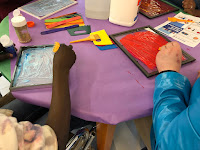 |
I love the month of May because that means our library is going to be filled with the wonderful artistic expressions of students in the Bloomfield Hills School District Art Show. We really wanted to make this fantastic art accessible for everyone in the community, so we held a sensory-friendly after-hours art appreciation event this past Friday. As with other sensory-friendly after-hours events we have held on Fridays, we kept the doors open upon closing at 6:30 pm exclusively for children, teens, and adults with disabilities along with their families. This gives people of all ages with disabilities the chance to explore the library and/or experience our sensory activities in a less crowded, low-stress, sensory-friendly environment, with visuals and a calming space in case of overstimulation. This is also a time when many feel more comfortable attending, as they can just be themselves. Whether it's stimming, loud tics or excited voices, this is a "no judgement (or shushing) zone." As one group of adults with intellectual disabilities was headed through the door and one of them spoke loudly in her excitement, the caregiver and others in the group looked at me with an apologetic glance. "No worries, that's what this night is for!" I said with equal excitement.
We provided a visual guide to the evening's activities in the lobby, along with a survey and handouts to help attendees explore our two pieces of touchable library art: our sculpture "Quest" (an adult sitting on a bench peering at an excited child holding a book over head in the background of the top image in this post) and the Conant Elementary School Legacy Project tile mosaic.
We also provided an ASL interpreter, a tour of selected works in the art show with verbal description for attendees with visual impairment, sensory activities, and more tactile art activities. Tactile art included this fantastic flannel book of tactile representations of four works of art from the neighboring Cranbrook Art Museum. Our incredibly creative library intern, Lauren Aquilina, wrote to Cranbrook for permission to recreate these pieces from their collection for our ArtABILITY event and then created this tactile masterpiece using fabric, foam, glue, puffy paint, buttons, pipe cleaners and yarn.

Our activities in the Youth Services Room included light table play, a very cool sensory painting activity from librarian Patricia Ballard, spring time discovery bin and textured paint play from librarian Andy Lebeck, and a cool-down space for those seeking a little sensory break.
We turned our story room into a cool-down space for sensory breaks.
The lights are dimmed and there are some tools provided to help with self-regulation, such as fidgets and weighted lap pads for people seeking sensory input and a pop-up tent (tall enough for adults) and sound-cancelling headphones for sensory avoiders.
Our special guest Caroline Braden, Accessibility Specialist at The Henry Ford, brought tactile activities to learn about the art of "Things That Go." People could wander into our Magazine Room to touch/feel miniature versions of the famous modes of transportation housed at The Henry Ford Museum, put together automobile pieces in a small assembly line and then put together an automobile craft to take home.
People could wander into the Adult Services area to design marshmallow structures, provided by Adult Services librarian, Ed Niemchak, who I will be introducing as a blog partner on here very soon!! Ed will be blogging about adaptive programming for teens and adults, including his monthly sensory story times at the BTPL. Yeah, Ed!
At 7 pm, a group of 8 met me in the lobby to head to our Community Room for a tour of 10 selected works in the student art show. I provided detailed verbal description to be inclusive of those who are blind or have low vision.
Here is one of my favorites from the students at the Wing Lake Developmental Center:
Image description: "Recycled Cap Flower" Medium used: cardboard with plastic bottle and jar caps. 18 x 6 inch rectangle cardboard background presented vertically and centered over vertical black board frame. The cardboard is spray painted green and blue. Over the cardboard background is a 3 dimensional flower shape. Creating the shape of a flower at the top are 23 yellow bottle caps in various 1 - 1 1/2 inch circular shapes with a large 3 inch white jar top in the center. Moving down from the flower top, there are 17 green circular bottle caps, 1 to 2 inches in diameter, trailing down to create a stem shape.
And of course, our attendees could also check out materials with our Head of Circulation, Anna Pelepchuk, at the Circulation desk!
Thanks also goes to Head of Youth Services, Marian Rafal, for greeting our attendees at the door and Pages Heather Coffee-Borden and Jessica Doroslovac for assisting with our activities! These after-hours events may not draw in big attendance numbers, but we are so glad to see the faces we don't see on a consistent basis. This was their time to explore art, literature and more in an accessible, low-stress environment.

























No comments:
Post a Comment